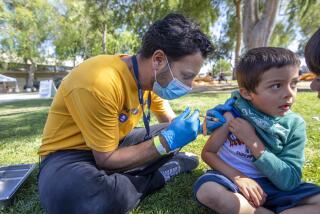Panel Endorses Vaccine for Lyme Disease
- Share via
WASHINGTON — The first vaccine to prevent debilitating Lyme disease took a step toward government approval Tuesday, after a federal advisory panel endorsed it, despite some lingering concerns.
If it is ultimately licensed by the Food and Drug Administration, the vaccine could help stem what is rapidly becoming the nation’s most common tick-borne illness: More than 100,000 cases in 48 states have been reported since 1982, according to the Lyme Disease Foundation. And most experts believe that this is a gross underestimate of the total.
The three primary areas where the disease is endemic are the West Coast--specifically California and Oregon--the Midwest, in Wisconsin and Minnesota, and along the northeastern coast from Massachusetts to Maryland.
In 1997, there were 172 cases reported in California, representing a 100% increase from the previous year, according to the federal Centers for Disease Control and Prevention.
The FDA frequently seeks guidance from its outside expert advisory committees in evaluating new drugs and other products. While panel recommendations are not binding, they typically carry considerable influence.
Karen Elkins of the FDA’s Center for Biologics Evaluation and Research said that the agency would “carefully consider everything the committee said. We’re working very hard to review this as quickly as humanly possible and will continue to do so.”
Panel members cautioned that numerous questions remain about the vaccine, among them whether it could be used in children--no one under 15 was involved in the testing--and whether it is safe for those with chronic arthritis or undiagnosed Lyme disease.
“It’s rare that a vaccine [is] voted on with such ambivalence and a stack of provisos,” said Dr. Patricia Ferrieri of the University of Minnesota, who chaired the committee.
Nevertheless, officials from SmithKline Beecham, the vaccine’s developer, said that they were encouraged by the panel’s action. “We are hopeful that Americans will soon have access to the world’s first vaccine for the prevention of Lyme disease in humans,” said Eddie Gray, vice president and director of the company’s U.S. vaccine’s division.
A similar vaccine is being developed by a second company, Pasteur Merieux Connaught.
Lyme disease, which takes its name from the Connecticut town where it was first identified in 1975, is caused by a spiral-shaped bacterium transmitted by ticks that carry the infection from animals to humans.
Often, its early symptoms are ignored or misdiagnosed or prove too mild to be noticed. When that happens, the chronic infection can cause serious nervous system problems and heart abnormalities months or even years later.
The disease typically begins with a characteristic “bulls-eye” rash at the site of the bite and can be followed by a flu-like illness. If untreated, it can progress to a chronic neurological disorder that involves arthritis-like symptoms--joint and muscle pain and swelling--and heart problems, such as irregular heartbeat and palpitations. If diagnosed early, it can be treated with antibiotics.
The new vaccine has been shown to be nearly 80% effective but it requires three injections over more than a year to build immunity. It appears to protect against the most common strain of Lyme disease found in the United States but does not protect against all strains.
Some of the other issues that concerned the panel include whether and how often booster shots will be required, as well as who should get the vaccine--everyone, or only those at higher risk of infection, such as park rangers who live in regions or people in occupations that expose them to ticks.
The advisory panel’s approval of the new vaccine came as many experts are predicting a bumper crop of ticks this summer because of the mild winter and wet spring in many parts of the country. But even quick FDA approval would not provide protection this year, since a year is required to achieve immunity.
To ward off ticks, experts recommend using an insecticide containing DEET and covering up--wearing long pants tucked into socks or boots and long-sleeve shirts--when active in the woods or bushy areas. But people may tend to ignore this advice when the weather is hot.
Lyme-carrying ticks--which typically are no bigger than the period at the end of this sentence--include deer ticks, Western black-legged ticks and possibly the Lone Star tick.






